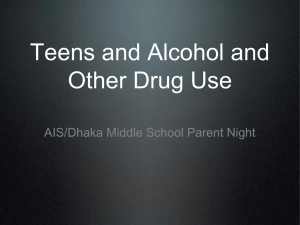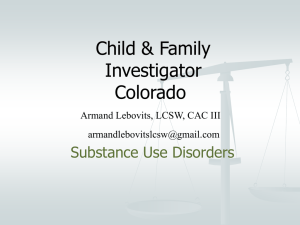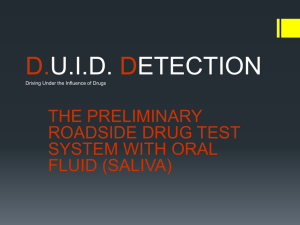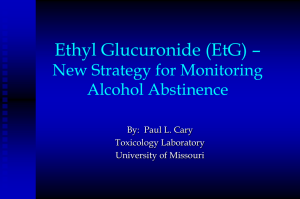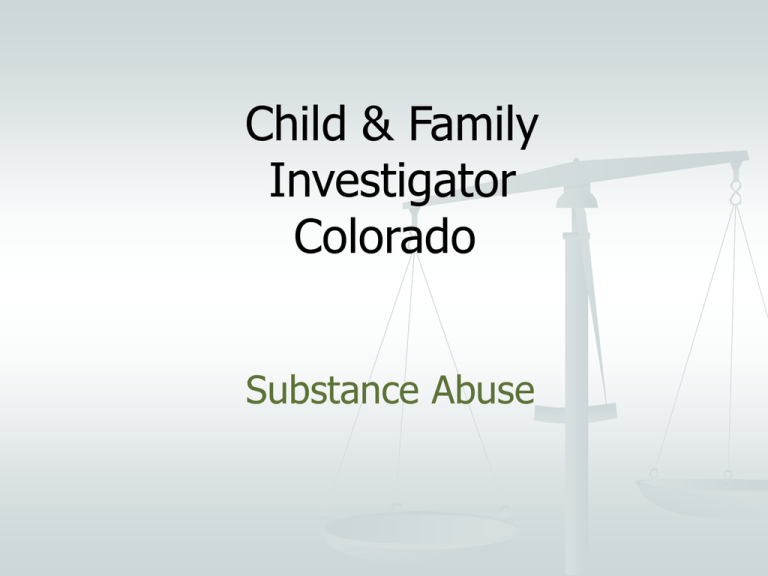
Child & Family
Investigator
Colorado
Substance Abuse
Substance Abuse
•
CJD 04-08 Standard 13
•
CFIs no longer “routinely” conduct testing
•
Make recommendations to court for testing and/or
evaluation if appropriate
•
Done by CFI only if sole issue of appointment, and if
qualified
Substance Abuse
An enormous problem
•
•
More than one in 10 in US live with dependent or
abusing parents
•
Profound effects on the children
Effects on Parenting
The effects of Substance Abuse on Parenting
•
•
Parent unavailable to child
•
Parent disappears
•
Parent wastes the resources of the family
•
Unstable housing, community and schools
•
Criminal activity, child endangerment
•
Child more likely to abuse
What the Child experiences
•
Broken promises
•
Inconsistency and unpredictability
•
Shame and humiliation
•
Tension and fear
•
Paralyzing guilt and an unwarranted sense of
responsibility
•
Anger and hurt
•
Loneliness and isolation
•
Lying as a way of life
•
Feeling Responsible and obligated
CHARACTERISTICS OF AN ADDICTION
DENIAL
IMPULSIVITY-SENSE OF IMMEDIACY
COMPULSION TO USE
LOSS OF CONTROL
TOLERANCE
WITHDRAWAL OF USE (OR
BEHAVIOR) LEADS TO DISCOMFORT
PROGRESSION OVER TIME
OTHER ADDICTIONS: It’s not just
about drugs
Internet
Pornography
Sexual
Gambling
Shopping
“Positive” Addictions (i.e. exercise)
UNDERSTANDING SUBSTANCE
ABUSE AND DEPENDENCE:
DSM IV DIAGNOSIS
CONTINUUM OF USE MODEL
-NO USE/NON-PROBLEM,
SOCIAL/RECREATIONAL USE, MISUSE,
EPISODIC ABUSE, ABUSE, DEPENDENCE
CO-OCCURRING M.H. DISORDERS AND
S.A. DISORDERS
DEFENSE MECHANISMS
IMPACT ON COGNITIVE, PSYCH. & SOCIAL
SYSTEMS
CONTINUUM OF USE MODEL
Social/Recreational
Heavy Drinking/Problem Drinker
Misuse
Sustained vs. Periodic Use
Abuse (Heavy Episodic Binging-5+ drinks)
Dependence (Psychological/Physiological)
Addiction/Addictive Behaviors
ADDICTION AS AN ATTACHMENT
DISORDER
A DISORDER IN SELF-REGULATION
DYSFUNCTIONAL ATTACHMENT STYLES
PADS VS. DAPS (PEOPLE ARE DRUG SUBSTITUTES
vs. DRUGS ARE PEOPLE SUBSTITUTES)
THOSE DEPENDENT ON ADDICTIVE SUBSTANCES
CANNOT REGULATE THEIR EMOTIONS, HAVE PROBLEMS
WITH SELF-CARE, SELF-ESTEEM AND INTERPERSONAL
RELATIONSHIPS
THE POPULATION
PRE/POST DIVORCE – USUALLY HIGH CONFLICT
OVERREACTION AROUND SUBSTANCE ABUSE/
DEPENDENCE
TENDENCY FOR ONE PARTY TO EMBELLISH AND
THE OTHER TO MINIMIZE
OFTEN DUAL-DIAGNOSIS ISSUES, TRAUMA…
THERE MAY BE CRIMINAL AND CIVIL LEGAL
ISSUES AT STAKE
GENERALLY, THIS IS A RESISTIVE POPULATION
GOALS OF A SUBSTANCE USE
EVALUATION
To understand the role that a substance plays in a
person’s life/level of involvement with the
substance
To determine how the substance use impacts the
person’s functioning
Cognitive: executive functioning, judgment, decisionmaking, tracking/monitoring, problem solving,
memory,
Psychological: mood, feelings, emotional regulation
Social/Legal/Occupational
Medical/Physical
To offer recommendations that can be
implemented into a parenting plan
To provide a piece of the puzzle for a larger
evaluation
THE TRUTH IS RARELY PURE
AND NEVER SIMPLE
OSCAR WILDE
COMPONENTS OF A GOOD
EVALUATION
Overview of the Assessment Process
Developing rapport during the evaluation
to reduce defensiveness and anxiety
Use of Assessment Tools
Brief Mental Status/Cognitive Screening
Instruments (AUI, SASSI-3, SUDDS-IV)
Drug Testing/Monitoring
History
Family of Origin: Hx of M.H., S.A., Trauma,
Abuse..
Relationship History
Substance Use: Current and Past
COMPONENTS OF A GOOD
EVALUATION
Use of Collateral Sources: spouse, family
members, custody evaluator, psychotherapists,
treatment programs, family doctors, criminal
records/motor vehicle records/COPDMP
Assessment of Motivation
Presentation/Demeanor
Stages of Change
Interpretation/Integration
- Cross-checking data
- Preponderance/concurrence of evidence
Report/Recommendations
WHAT GETS US INTO TROUBLE
IS NOT WHAT WE DON’T KNOW,
IT’S WHAT WE KNOW FOR SURE
THAT JUST AINT SO!
MARK TWAIN
KEY CONSIDERATIONS
Is the concern a current problem
(within the past 12 months)?
How much of a factor is the stress of
the divorce?
Has use occurred during parenting
time/Does use impact parenting?
Documented history vs. “He said, She
said”?
KEY CONSIDERATIONS
Past substance use and mental
health treatment history/records?
Is concern based on single or
multiple episodes?
Meaning of allegations in the context
of the divorce dynamics.
Are there concerns about the
credibility of the
accuser/allegations?
IMPLICATIONS FOR PARENTING PLANS
Overall concern is keeping children safe
Do there need to be restrictions on parenting
time?
Do the parents need treatment?
Do children and/or other family members need
treatment or support?
IMPLICATIONS FOR PARENTING PLANS
Is limited substance use OK?
What defines relapse/How to
respond?
Is monitoring necessary?
IMPLICATIONS FOR PARENTING
PLANS:
MONITORING STRATEGIES
What Tests to Use:
Breath/Saliva testing
Urine testing
Blood testing
Hair testing
Transdermal (Sweat)
Frequency of Testing: Random or Fixed
Duration of Testing
Response to Missed, Dilute or Positive
Tests
Recommendations and Treatment
Resources
Self-management (no use at times prior to
parenting time)
Drug Testing/Monitored Antabuse
AA, CA, NA, LifeRing
Individual, family or group counseling
Intensive Outpatient Program or Inpatient Tx
Psychiatric Referral for consultation/medication
DSM-IV criteria
Substance dependence
•
•
Tolerance of the substance
•
Withdrawal
•
More amounts, no efforts to control
•
Time and resources spent obtaining substance
•
Outside activities fall away
•
Continued use in spite of significant problems
DSM-IV criteria
Substance abuse
•
•
•
Failure to fulfill major obligations
•
Physically dangerous situations
•
Related legal problems
•
Persistent or recurrent social or interpersonal
problems
A person is either dependent or abusing a particular
substance, not both at the same time
American Psychiatric Association DSM-5 Development
Proposed Revision
Substance-Use Disorder:
A. A maladaptive pattern of substance use leading to clinically
significant impairment or distress, as manifested by 2 (or more) of
the following, occurring within a 12-month period:
recurrent substance use resulting in a failure to fulfill major role
obligations at work, school, or home (e.g., repeated absences or
poor work performance related to substance use; substance-related
absences, suspensions, or expulsions from school; neglect of
children or household)
recurrent substance use in situations in which it is physically
hazardous (e.g., driving an automobile or operating a machine when
impaired by substance use)
continued substance use despite having persistent or recurrent
social or interpersonal problems caused or exacerbated by the
effects of the substance (e.g., arguments with spouse about
consequences of intoxication, physical fights)
American Psychiatric Association DSM-5
Development
Proposed Revision
tolerance, as defined by either of the following:
a. a need for markedly increased amounts of the substance to
achieve intoxication or desired effect
b. markedly diminished effect with continued use of the same
amount of the substance
(Note: Tolerance is not counted for those taking medications under
medical supervision such as analgesics, antidepressants, ant-anxiety
medications or beta-blockers.)
withdrawal, as manifested by either of the following:
a. the characteristic withdrawal syndrome for the substance (refer
to Criteria A and B of the criteria sets for Withdrawal from the
specific substances)
b. the same (or a closely related) substance is taken to relieve or
avoid withdrawal symptoms
(Note: Withdrawal is not counted for those taking medications
under medical supervision such as analgesics, antidepressants, antianxiety medications or beta-blockers.)
American Psychiatric Association DSM-5
Development
Proposed Revision
•
amounts or over a longer period than was intended
•
a great deal of time is spent in activities necessary to obtain the
substance, use the substance, or recover from its effects
•
important social, occupational, or recreational activities are given up
or reduced because of substance use
•
the substance use is continued despite knowledge of having a
persistent or recurrent physical or psychological problem that is likely
to have been caused or exacerbated by the substance
•
Craving or a strong desire or urge to use a specific substance
American Psychiatric Association DSM-5 Development
Proposed Revision
Severity specifiers:
Moderate: 2-3 criteria positive
Severe: 4 or more criteria positive
Specify if:
With Physiological Dependence: evidence of
tolerance or withdrawal (i.e., either Item 4 or 5 is
present)
Without Physiological Dependence: no evidence of
tolerance or withdrawal (i.e., neither Item 4 nor 5 is
present)
Relapse
•
Now recognized to be standard piece of the road to
recovery
•
How will this affect your recommendations?
•
How can safety be provided for the child?
A Brain Disorder
Mesolimbic dopamine system
•
•
•
Pleasure pathway
•
Creates attachment
•
Drug use is self-medication
Behavioral extremes
DBT: Dialectical Behavior Therapy
OVERVIEW:
• DRUG AND ALCOHOL CATEGORIES AND
TOXICOLOGY
• BASICS OF AVAILABLE DRUG TESTING,
SCREENS AND CONFIRMATION TESTS
• NEW TECHNOLOGIES
• MONITORING STRATEGIES
- daily, fixed, periodic or random
oral/saliva/breath/blood/urine/hair/patc
h
Substances of Abuse
•
•
•
•
•
•
•
Alcohol
• Amphetamines/Meth/Ecstasy
Barbiturates
• Benzodiazepines
Cannabis
• Cocaine
Hallucinogens • Opiates
Prescription Medications
Anabolic Steroids
Designer Drugs (incense, synthetic THC)
TOXICOLOGY:
Oral Fluids/Saliva (Strips, Swabs)
Breath (Balloons,Tubes,Breathalyzers,
Sobrietor, InHome, Soberlink, Smart
Start)
Blood (MD authorized lab. procedures)
Urine (Screens/Chemical or IA, GC/MS,
LC/MS/MS)
Hair (Head, Axillary, Body)
Transdermal (Patch, SCRAM)
Parent Drug vs Metabolites
Alcohol (Ethanol) -Ethyl Glucuronide (EtG)
-Ethyl Sulfate (EtS)
• Cocaine -Benzoylecgonine
-Cocaethylene
-Norcocaine
• Marijuana (THC) -Cannabinoids 50
Testing Limitations/Problems:
Chain of Custody/Forensic Collection Process
Time Limitations & Elimination Rates
Errors and Fallibilities (Immunoassay/Chemical
assay vs Gas Chromatography/Liquid
Chromatography/Mass Spectometry)
Analysis/Interpretation of Tests (Negatives, False
Negatives, Detection Levels)
Chain of Custody and Forensic Collection
Process:
Is the testing site licensed,with certified staff (CLIA) that
follow Federally Mandated SAMHSA Guidelines,
Procedures and Detection/Cutoff Levels?
• Do they follow Federal DOT Chain of
Custody Guidelines:
-Driver License Identification
-Same gender observation for
UA’s
-Labelling/Sealing of Specimen
-Transportation and Testing
Procedures
Elimination Rates
Alcohol- 0.6-1.0 drinks per hour
Metabolites EtG and EtS up to 80-84 hours
Amphetamines-1 to 3 days
Methamphetamines-3 to 5 days
Methylenedioxy-methamphetamine (MDMAEcstasy)-3 to 4 days
Barbiturates-1 to 3 days (Phenobarbitol
L.A.up to 2-3 weeks)
Benzodiazepines-range from 2 to 7 days
and with long term use up to 4-6 weeks
Elimination Rates
• Cocaine (metabolite-Benzoylecgonine)-1 to 2 days
and up to 5 days with serious abuse
• Opiates (Heroin,Codeine, Morphine,Oxycodone,
Oxycontin, Hydromorphone)-1 to 3 days
Methadone-1 to 3 days
• Marijuana/Cannabis (THC)-varies significantly with
quality, amount/frequency of use, activity level
(and stores in lipid tissue):
-Occasional User-3 to 10 days
-Recreational/Social User- 5 to 10 days
-Daily/Chronic User-30 to 45 days
• Phencyclidine (PCP)-usually 1 to 2 days (up to 7 to 14 days)
Errors,Screening and Confirmation Tests
Immunoassay or Chemical Assay Screens
False positive error rate of 1/200 to 1/400
Large cross reactivity with other substances
and other drugs
• Gas Chromatography/Mass Spectometry
(GC/MS) Confirmation Test (to identify and
quantify at a higher level)
• Liquid Chromatography/Mass
Spectometry/Mass Spectometry
(LC/MS/MS) is the platinum standard in
testing
Analysis and Interpretation of Tests
Negative Result does not equal no use!
-the use can be under the detection or cutoff
level (for IA, GC/MS, or LC/MS/MS)
for screens or confirmation tests (for
saliva, breath, urine, blood, hair,transdermal, etc.)
• If Positive Result for GC/MS or
LC/MS/MS for UA or Hair tests it’s
Positive
Oral Fluids/Saliva Toxicology Screens
Alcohol and Drug Screens are available
Rapid Screening Devices that are inexpensive and
can screen for most substances
More sensitive to recent oral/nasal use of substances
and is present before showing up in the urine
More false negatives (can dilute/cleanse oral
cavity)
- False positives from alcohol in mouthwash,
Nyquil,cold medicines,etc.
Saliva Toxicology (Cont.)
Alcohol Qtip Swab Saliva Screens
can screen up to .15 BAL; thermometer like
(expensive- 10 for $130.00)
Alcohol Screen Saliva Test Strips-at .02 BAL; change
color (inexpensive-24 for $66.00)
BreathScan Alcohol Screening Test-at .02
BAL; squeeze and break center and then blow into
tube and then changes color (inexpensive-25 for
$68.75)
• Oral Fluid Drug Screen Device-tests for Alcohol,
THC, Cocaine, Opiates, Meth &
Amphetamines, Benzodiazepines
(inexpensive-25 tests for $375.00)
Breath Toxicology
Breath Sensors/Breathalyzers for Alcohol
blow into straw or tube
can read BAL that is time/date stamped and
can be scrolled up and down and store 500-600
readings
easy to use and portable
reliable and inexpensive to purchase or lease
• Sobrietor for Alcohol; telephone modem
based breathalyzer through BI,Inc.
- reliable and inexpensive also
Urine Toxicology Screens and Confirmation
Tests
Tests for most substances of abuse
Usually 5 or 7 panel tests (7 panel adds
Benzodiazepines and Barbs) + Creatinine Level for
dilution
Can include EtG and EtS tests
Can include Anabolic Steroids testing (as in hair &
blood testing)
Can request to test for other substances
GC/MS and LC/MS/MS very reliable
Negative results can mean under
detection or cutoff level
Urine Toxicology (Cont.)
• Specimen Validity Tests
Creatinine Level
Basic Adulteration Tests
for odor, color, physical characteristics like
temperature and or abnormal instrument response
•
Masking Attempts with Detox Teas,Golden
Seal Tea, Lavage,and other agents
(bleach, drano, etc.)
• Substitution with clean urine, Wizonators, plastic bags and tubes
Whizzinator (Priceless!) comes complete with fake penis,
dried synthetic or clean urine, chemical heater packs,
thermometer)
Urine Toxicology (Cont.)
• False Positives related to Diabetes for alcohol
testing and urinary tract and bacterial
infections for EtG testing
• EtS testing not effected by Diabetes, urinary tract and
bacterial infections
5 or 7 panel-lab test from $15-30.00
EtG and/or EtS tests from $35-65.00
LC/MS/MS tests slightly higher than GC/MS
(www.etg.weebly.com for Dr. Skipper’s information Replaces www.ethylglucuronide.com site)
Hair Tests
Very reliable-if positive, no false positives
Increased window of detection to 90 days
Deterrent to drug use
Cocaine metabolites detected up to 3 months
False Negatives for EtG/Alcohol-bleaching/dyeing hair/shampoo kits
Does not capture recent drug use of last 1 1/2 to 2 weeks
Suggest periodic tests every 10 weeks to not have
lacunae or gaps in testing
• Urine Toxicology Screens and Tests for two weeks
prior to initial hair test if possible
• Usually head hair sample will be 1 1/2 inches long
and pencil diameter in thickness (150-200
strands)
Hair Testing (Cont.)
Axillary (armpit) or Body hair testing can detect prior
drug use up to 1 year
Usually 5 or 7 panel test
Cost from $70-150.00
• Limitations:
Cannot test for Alcohol
Cutoff levels may not capture occasional or
infrequent use
Darker hair more susceptible to picking up drug use
Transdermal Toxicology-Patch Screening
Fairly Reliable
Increased window of detection to 7 days
Deterrent to drug use
No sample dilution or substitution
Parent drug and metabolites-no alcohol testing
Unknown sensitivity and specificity to environmental
exposure or pre-existing drug contaminants on skin
•
Cost approximately $36.00 (AlcoPro or PharmChek or
pharmchem.com at 817.590.2537(or 0571)
SCRAM-SECURE CONTINUOUS
RANDOM ALCOHOL MONITORING
Transdermal alcohol detection via ankle monitor that is downloaded by
land-line telephone modem for readout to service center or downloaded
twice weekly at service center. Positives lead to EtG testing for
confirmation.
24/7 detection window-Cost is approximately $13-14.00 daily
(Rocky Mountain Offenders Management, 8787 Turnpike Dr.,Westminster,
303.443.4277)
SleepTime Monitoring
•
•
•
24/7 Alcohol and Other Drug Abuse Monitoring System
Wrist actigraphy monitor, FDA cleared medical device used for sleep
studies, detects erratic sleep patterns that are reliable
indicators of alcohol and drug abuse and recommends EtG and other urine
testing to verify episodes of apparent substance abuse
Downloaded on Monday and Thursdays; Cost $3.50/day + $39.00 per +
drug test (ICCS, 1651 Kendall, Lakewood, 303.232.4002)
IMPLICATIONS FOR PARENTING PLANS
Overall concern is keeping children safe
Do there need to be restrictions on parenting
time?
Do the parents need treatment?
Do children and/or other family members need
treatment or support?
What Tests to Use:
- Oral Fluids/Saliva testing
Breath testing
Urine testing
Blood testing (Prescription Drugs) and AlcoholPhosphatidylethanol-Peth)
Hair testing
Transdermal (Sweat)Patch
SCRAM (Secure Continuous Random Alcohol Monitoring)
SleepTime
Frequency of Testing:Daily, Fixed, Periodic, Random
Duration of Testing
Response to Missed, Dilute or Positive Tests
Recommendations and Treatment
Resources
Self-management (no use at times prior to
parenting time)
Drug and Alcohol Screens, Testing and Monitoring
Use of Medications ( Monitored Antabuse (Disulfiram) and
Acomprosate (Campral), Vivitrol and Naltrexone, Suboxone
AA, CA, NA, LifeRing
Individual, family or group counseling
Intensive Outpatient Program or Inpatient Tx
Psychiatric Referral for consultation/psych. medications
QUESTIONS AND DISCUSSION:
Toxicology Web Links:
www.norchemlab.com
www.omegalabs.net
www.questdiagnostics.com
www.redwoodtoxicology.com
www.usdrugtestinglab.com
MEDICAL MARIJUANA ISSUES
Marijuana is illegal under federal law
Regulation of the industry is on-going and
evolving
Medical marijuana is a political, legal, health and
moral issue
Do people really qualify or do they just want to
get high?
Should drug abuse be treated as a health issue,
a legal issue, a moral issue or all?
MEDICAL MARIJUANA ISSUES
•
What or has anything changed in assessing cannabis use with medical
marijuana recommendations?
•
Right to use in Colorado but not a Right to be Impaired when parenting
children!
Dosing Issues (Smoking, Vaporizers, Edibles, Tinctures, Oils)
Right to Use vs. Impact on Personality Functioning (Impact on Parenting
Capacity)
Research-What we know about impact on Executive Functioning/Motor
Skills
Marijuana and Tolerance and Adaptation to use?
MEDICAL MARIJUANA ISSUES
• Previous History of Cannabis Use/Abuse/Dependence? Prior to Card?
• Environmental Concerns, Exposure of Children to smoke (clothes/backpacks),
cannabis and edibles unlocked at home (infants/toddlers/pre-schoolers)
• Impact on Emotional and Behavioral Attunement of Parents
with children (Ability of Parent to regulate emotions and reflect on child?)
• Aspirational aspects of having parents not use 12 hours or longer or during
parenting time; Window of Detection Issues (Can this be enforced or
monitored?)
• Can we regulate prescriptions? (No control over their dosing)
MEDICAL MARIJUANA ISSUES
Is there a documented history of debilitating disorders?
Is using medicinal cannabis the best practices for the medical issue?
How is assessment the same or different for pain medications and medical
marijuana?
•
When should a pain specialist be used for pain assessment or when to use
an IME (Independent Medical Evaluation)?
•
Medical Marijuana and CPS (neglect and abuse?)
•
Medical Marijuana Use and DUID’s (Children in vehicle)
•
How do we safeguard children from parents that use cannabis regularly?
Can we?

